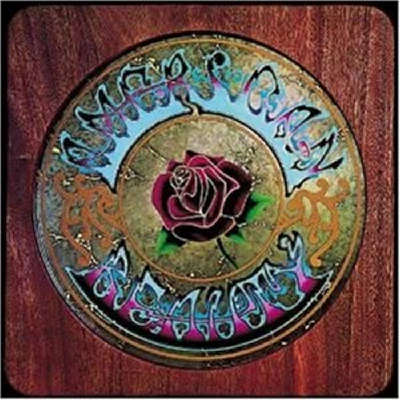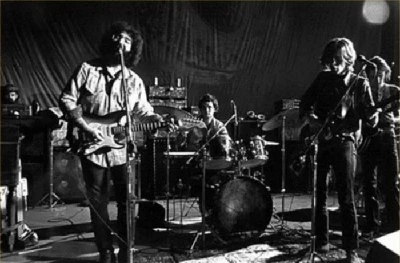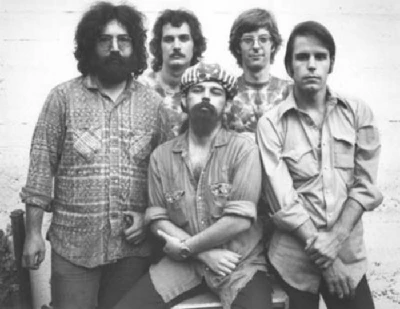published: 22 /
5 /
2009

In our 'Re : View' series, in which our writers reflect upon albums from the past, new writer Carl Bookstein examines the Grateful Dead's 1970 masterpiece, 'American Beauty'
Article
'American Beauty', which was recorded by the Grateful Dead in 1970, is consciousness expanding, soul healing music that takes you back home, wherever home is. 'American Beauty' represents the apex of the Grateful Dead’s studio recording career.
After all, the Dead are first and foremost a live band. Live, without a net, is how the Dead explore, invent and create. Never, however, was the quintessential comfort of the Grateful Dead’s music better captured than on 'American Beauty'.
When I first heard 'American Beauty', it encapsulated for me a more inviting world than the somewhat mundane life of a young student in a college town. The recording led me to yearn for a life out on the road, where I could taste the beauty of the American countryside. Upon introduction, my cassette of it rarely left my tape player.
In the Dead’s overall body of music one can hear various influences including psychedelic rock, blues, rock, country, bluegrass, folk and improvisational jazz. The Grateful Dead embodied the San Francisco music scene of the mid to late 1960s and came to represent the counterculture to mainstream America.
The Dead’s epic free form live shows, complete with a traveling circus atmosphere, were rites of passage for the ever growing congregation of listeners, the Deadheads. Drawing from a wide variety of songs, combined with the improvisational nature of their playing, each Grateful Dead concert was genuinely different from the last.
'American Beauty' along with 'Workingman’s Dead', which was also recorded in 1970, is part of a progression away from the psychedelic experiments of the Dead’s earlier albums. Formed in 1965, the Dead then under the name the Warlocks, were the house band for the Acid Tests, which were held mostly in Northern California and helped to popularize the drug LSD. 'American Beauty' is a great leap from these origins.
'American Beauty' is primarily acoustic music with delicate layered vocals at the forefront. The album represents a return to the roots of American music and was influenced by the late 1960s' roots conscious work of Bob Dylan and the Band.
The album showcases the songwriting of lead guitarist and singer Jerry Garcia and his partner lyricist Robert Hunter. 'American Beauty' finds Garcia and Hunter reaching a peak in their collaboration, writing some of the strongest songs in the band’s history.
The Grateful Dead in 1970 were Garcia, singer and guitarist Bob Weir, Phil Lesh on bass and vocals, Bill Kreutzmann and Mickey Hart on drums and Pigpen (Ron McKernan) on harmonica, keyboards and vocals. The band achieves on 'American Beauty' a sound that is earthly, well defined and quietly powerful. The vocal harmonies with Garcia, Weir and Lesh are positively lovely.
Legions of listeners, who found the Dead’s more improvisational music inaccessible, were drawn in by these songs and went on to appreciate the whole Grateful Dead catalogue.
'Box of Rain', the opening track, washes over the listener with soothing sound. Phil Lesh wanted a song to sing to his dying father and had composed the music. Robert Hunter then wrote the lyrics. It has an evocative melody that tugs on the heart strings. The melody is matched with a beautiful lyric filled with simple wisdom.
“Walk out of any doorway
feel your way, feel your way
like the day before
Maybe you’ll find direction
around some corner
where it’s been waiting to meet you”
Phil Lesh’s vocal is right on the mark. 'Box of Rain' is the ultimate healing song and the perfect album opener.
Next is 'Friend of the Devil', a great story song about a man on the run from the law, covering territory in the western U.S. from Reno, Nevada to Utah and sung poignantly by Jerry Garcia. The acoustic instrumentation is beautiful, including excellent mandolin work by guest David Grisman that adds a lot to the song. 'Friend of the Devil' is one of the Dead’s tunes which, despite the narrator’s struggles here, captures the romance of the road.
The Grateful Dead symbolized the call of the road and the call of adventure in the same way that Jack Kerouac’s Beat-era novel, 'On the Road', did. Answering the call of the Dead could make a deadhead’s life something magical. Being a deadhead is tribal - something akin to religion. It is an addiction to both the music and the scene surrounding the band.
Jerry Garcia was a compelling figure, a great guitarist and composer as well as an under-appreciated singer. In Garcia’s voice, one can hear a lullaby of humanity.
At a Dead show, one entered into a hippie gypsy carnival—actually something of a paradise in a parking lot, with choices ranging from vegetarian burritos to a wide assortment of tie-dye. The rich and varied music along with the parking lot 'Dead-mart' came together for a transcendental experience. The Grateful Dead concert-goer entered a vibrant new world.
'Sugar Magnolia', which is sung by Bob Weir, keeps 'American Beauty' running on the highest level. Something of a country rock song in the original version, 'Sugar Magnolia' became an all-out rock 'n' roll number in the Dead’s live shows.
'Operator', sung by the then ailing Pigpen, is a folk blues number. Pigpen was a heavy drinker and died in 1973 at the age of 27 of liver failure. 'Candyman' flows with another hypnotic Jerry Garcia vocal. The album remains enchanting nearly forty years after having been recorded.
Next is the gorgeous Garcia/Hunter folk ballad 'Ripple'. This music is earthbound Americana. Garcia sings of life’s journey and his voice provides true comfort : “If I knew the way, I would take you home.”
Like other songs on this album, 'Broke-Down Palace' tells of a traveller’s journey. The lyrics focus on imagery of the waterside. Deadheads who travelled from city to city with the band on their legendary tours could knowingly connect with the lyric : “Mama, mama, many worlds I’ve come since I first left home.”
The Dead’s albums often did not live up to the promise of their concerts. 'American Beauty' is the exception : a satisfying fully realized work. The vocals and instrumentation of the album are crystal clear.
'Attics of My Life' is one of the prettiest songs in the Grateful Dead catalogue. The three part vocal harmonies of Garcia, Weir and Lesh blend together perfectly. The narrator tells of a time : “when there was no ear to hear, you sang to me.”
The song captures rare images and holds them dear, as do the deadheads hold dear the music and the scene they follow.
“In the attics of my life
Full of cloudy dreams unreal
Full of tastes no tongue can know
And lights no eye can see”
'Truckin’', the closer, is an autobiographical story song about life on the road. The cities blend together: “Chicago, New York, Detroit, it’s all on the same street.” 'Truckin’' is the hit of the album and its most famous song. It is also the most rocking number here, as the thus far journey of the band is chronicled.
“Sometimes the light’s all shining on me
Other times I can barely see
Lately it occurs to me
What a long strange trip it’s been”
'Long Strange Trip' has become a catchphrase for the Grateful Dead experience. The band’s life and music have been a true odyssey with 'American Beauty' standing out as an absolute high point along the way.
The Grateful Dead went on from 'American Beauty' to perform some of their best live music in the 1970s, as bootleg recordings from that time continue to prove. The band became a huge live draw in the 1980s, particularly with the success of their 1987 album 'In the Dark' and the radio hit 'Touch of Grey', the first ever Dead track to reach the top ten on the pop charts. The Grateful Dead continued selling out stadium shows through their summer tour in 1995. In August 1995 Jerry Garcia died of a heart attack at age 53 at a substance abuse treatment facility in Forest Knolls, CA.
The remaining members of the band continue to tour today under simply the name the Dead.
Track Listing:-
Picture Gallery:-

